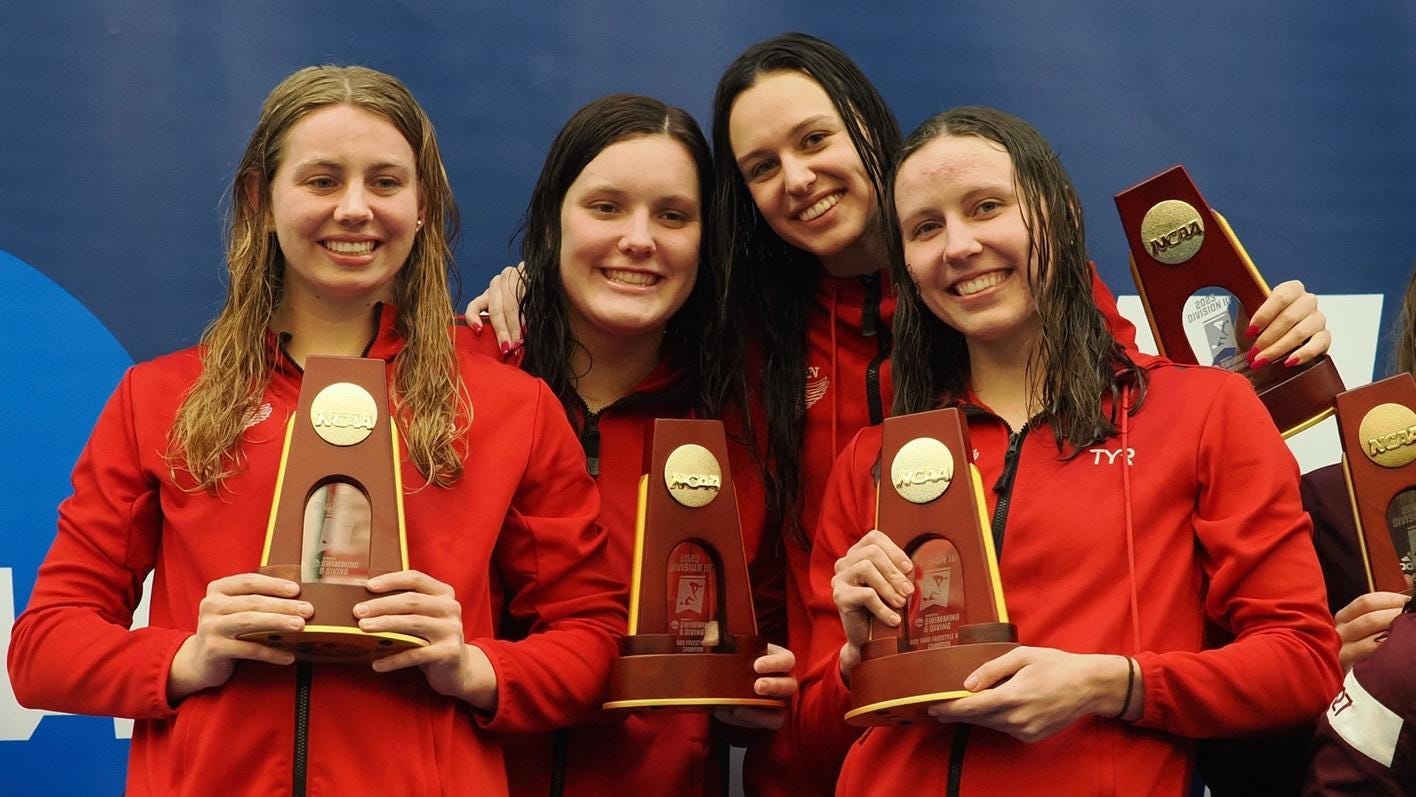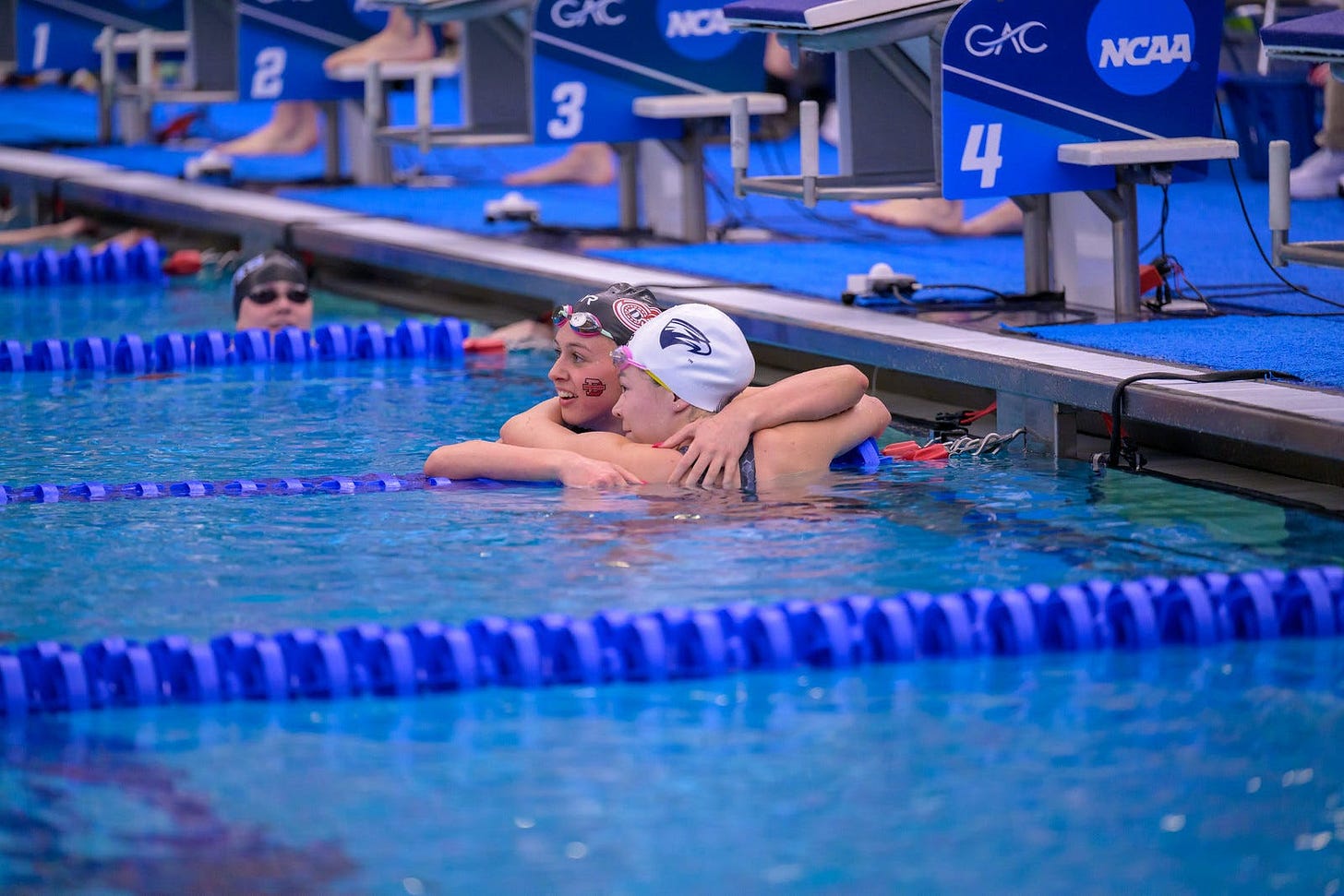Chalk
The first day of the 2023 Women's Division III National Championship, and what it suggests about the vices and virtues of predicting meet outcomes using seed times and event rank.
When the NCAA released the psych sheet for Division III Nationals, SwimSwam’s instinctual response was to post SCORING THE 2024 NCAA DIVISION III PSYCH SHEETS. Because who among us can view a psych sheet and not immediately start to game-out who is going to win? Why fight it?1
Vice
When it comes down to the particulars, psych sheets are not very good at predicting the future. Which is kind-of a let-down, given that they seem to promise gratification of a totally reasonable desire to know what will happen next, especially as it relates to things we care about most (like our own performance, or the happiness of loved-ones).
Take, for example, the first day of the 2023 Women’s Division III National Championship.
Some quick history
Last season, through late January, any conversation about a Women’s National Championship would have revolved around Kenyon and Emory, with Kenyon maintaining a bit of an advantage, and Denison a clear third. Here’s what a hypothetical psych sheet would have predicted for point totals at Nationals2 based on times through January 28th:
Kenyon College - 454
Emory University - 435
Denison University - 413
As late as February 8th, the hypothetical psych sheet would have had the same ranking, with Denison narrowing the points gap somewhat.
Kenyon College - 438
Emory University - 415.5
Denison University - 414
NCAC’s changed that. Denison of course beat Kenyon in the conference championships by a narrow margin.3 But most telling was that by the end of the day on February 11, this is how a psych sheet would have predicted things would end at Nationals a month later.
Denison University - 511.5
Kenyon College - 431
Emory University - 392
Denison was rounding into the form that would make them so intimidating at the start of NCAAs. The exact number totals would shift as the NESCAC teams made their annual last-season surges, but the gap between Denison and the field only grew. If you count the diving events, the psych sheet had Denison finishing +94 points over the field.

Day 1
Given that Denison fulfilled their destiny and won the 2023 Women’s Division III National Championship, it is easy to forget that on Day 1 things went sideways for the Big Red.
500 Free
Expecting 54 points from the 500 Free, Denison emerged with 49. Taryn Wisner and Tara Witkowski shed where expected - 2nd and 3rd - and Emily Harris jumped up from her expected B Final slot to finish 5th overall. Quinn Brown, expected to A Final, instead placed in the B Final (a wash for the team, given that Ms. Harris took 5th).4 Anna Pfeufer was supposed to have a safe B Final slot but did not have her best race and wound up in this nightmare:
Yeh, that’s a 500 Free swim-off. Oof. Ms. Hallmark took the 16th spot (congratulations to her - she will return to Nationals this year and swim the mile), and Ms. Pfeufer finished out of the points.
Not helpful to Denison were Sarah Hoffman and Molly Haag of Kenyon who combined for 18 points, which was 18 more points than the psych sheet predicted for Kenyon in this event.
After 500 Free
Chalk: Denison, 54 points total, +54 v. Kenyon and Emory
Actual: Denison, 49 points total, +21 v. Kenyon, +49 v. Emory200 IM
Expecting one A Finalist in this event (CC Crane) and two B Finalists - Senior Emma Berdelman and First-Year sensation Phoebe Ferguson - Denison was unpleasantly surprised when Ms. Crane fell to the B Final, and Ms. Ferguson DQ’d.5
There was also a small setback for Kenyon as Jennah Fadely fell to the B Final.6
After 200 IM
Chalk: Denison, 75 points total, +59 v. Kenyon and +66 v. Emory
Actual: Denison, 57 points total, +26 v. Kenyon and +59 v. Emory50 Free
Denison star Tara Culibrk A Finaled as expected. But Denison was also expecting two more Big Red swimmers in the B Final and that did not work out. Kenyon dropped a few points (6 points) by coming in a little behind in the expected order of finish, just enough to keep this event from getting truly uncomfortable for Denison. This was also the first event of the day that really played to Emory’s strengths, as Taylor Leone and Caroline Maki both made the A Final
After 50 FR
Chalk: Denison, 98 points total, +51 v. Kenyon and +57 v. Emory
Actual: Denison, 74 points total, +18 v. Kenyon and +45 v. Emory3 Meter Diving
This event announced that Ariana Khan was going to be among the most valuable performers for Emory at this meet.
She took first in this event, and would take second in the 1 Meter event. That gave her 37 points for the meet, placing her just behind superstars Caroline Maki and Taylor Leone in the Eagles high-point ranking. Tess Klugherz contributed another diving point for the Eagles.
Denison’s diver, Kerstyn Johnson, finished 9th, worth 9 points. That was a little off the expected order of finish for the Big Red diver.
After 3 Meter Diving
Chalk: Denison, 113 points total, +66 v. Kenyon and +61 v. Emory
Actual: Denison, 83 points total, +27 v. Kenyon and +33 v. Emory200 Medley Relay
Denison was slated to finish 5th, behind Kenyon, Emory, MIT and Pomona-Pitzer. However, two NESCAC teams - Williams and Tufts - elbowed their way past Denison, pushing the Big Red down to 7th place. It was a loss of only 4 points. But it was another loss of points, in a day where Denison did not hit their psych sheet predicted totals in any event.
After 200 Medley Relay
Chalk: Denison, 141 points total, +54 v. Kenyon and +55 v. Emory
Actual: Denison, 107 points total, +17 v. Kenyon and +17 v. EmoryVirtue
It is not hard to spot the vices of predicting meet outcomes through seed times and the expected order of finish on the psych sheet. Stuff happens, swimmers get off to a slow start, atypical DQs are called, other swimmers on other teams exceed all expectations. It is what makes a swim meet way more fun than reading a psych sheet.
What then are the virtues of using psych sheets to predict meet outcomes?
Well, in this case, the psych sheet was right, in the only way that really mattered. The psych sheet showed a huge Denison advantage, so large that - as it turned out - even a first day full of slow starts and bad luck did not dislodge Denison from the lead spot. And the next day, the Big Red scored 174 points - almost precisely matching the expected point total from the psych sheet. A lot of cool stuff happened at Nationals after the second day, but none of it was particularly relevant to who would win the Women’s National Championship. As the psych sheet foretold, 2023 Nationals was one long coronation for the Denison Women.
In fact, we believe the healthiest approach is to explore this impulse directly, in careful detail. To explore how this impulse is simultaneously counterproductive and productive. To, as a concerned therapist might suggest, get it out in the open.
Also, none of this should be read as a snark about the fine work of SwimSwam contributor Laura Rosado. In fact, our criticism would be that we want more Laura Rosado, and the high-quality NCAA swimming coverage she provides.
Also, SwimSwam associate editor Riley Overend, amidst high quality high school and college coverage, is writing a fascinating, cringe-inducing account of what appears to be the rank mismanagement and utter financial collapse of USA Swimming. Is anyone else noticing this?
NCAA DIII Championships - 3/15/2023 to 3/18/2023
In a meet marred by 24 disqualifications, after 23 DQs the year before. In other sports, like football, baseball/softball, basketball, hockey, soccer…basically every sport that does not have trouble attracting spectators, players and coaches play some role in policing the conduct of officials. This can take the form of established procedures for in-the-moment protests, a certain tolerance for team captains directly addressing officiating shortcomings with officials during the contest, written rules allowing athletes and coaches to request that one official help another with a difficult call, all the way to the ritualized and choreographed ways that baseball/softball managers are ejected from the game under certain circumstances as a way of drawing attention to officiating problems while protecting the eligibility of their players.
The relationships between the athletes and officials in swimming is broken. If you want an example, go ahead and google Owen Lloyd. Most of the articles you will find on this incident suggest that the rule is the problem. The rule is not the problem. The problem is the relationship between athletes (and coaches) and officials in NCAA swimming. That rule should stay on the books, because sportsmanship is important, but Mr. Lloyd should have received an in-the-moment warning to get back in his lane, not be disqualified and his title taken from him for doing something that in fact hindered no other swimmer.
Officiating in baseball, soccer, basketball, etc. all have well known problems at all levels of the sport. They all also look positively enlightened compared to NCAA swimming.
Ms. Brown, a terrific athlete and major contributor for the Big Red, was also one of the many victims of the preposterous string of DQs on the first couple of days of the NCACs. There’s video. Go watch the start, in real time, using a field of view that allows you to see more than one swimmer at a time (like an official would). Tell us if you think that is a DQ.
At least the Nationals HyTek tells you what the dq was for: Downward butterfly kick - breast.








haha, appreciate the shout-out. will do my best to improve the d3 content on that other website (I know I'm extremely late to the party) (and if you'd like to chat, you can find me on twit/x: @lrmrosa)